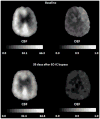PET in Cerebrovascular Disease
- PMID: 20543975
- PMCID: PMC2883245
- DOI: 10.1016/j.cpet.2009.12.007
PET in Cerebrovascular Disease
Abstract
Investigation of the interplay between the cerebral circulation and brain cellular function is fundamental to understanding both the pathophysiology and treatment of stroke. Currently, PET is the only technique that provides accurate, quantitative in vivo regional measurements of both cerebral circulation and cellular metabolism in human subjects. We review normal human cerebral blood flow and metabolism and human PET studies of ischemic stroke, carotid artery disease, vascular dementia, intracerebral hemorrhage and aneurysmal subarachnoid hemorrhage and discuss how these studies have added to our understanding of the pathophysiology of human cerebrovascular disease.
Figures










Similar articles
-
PET in Cerebrovascular Disease.PET Clin. 2010 Jan;5(1):83-106. doi: 10.1016/j.cpet.2009.12.007. Epub 2010 May 27. PET Clin. 2010. PMID: 27157485 Review.
-
The use of positron emission tomography in cerebrovascular disease.Neuroimaging Clin N Am. 2003 Nov;13(4):741-58. doi: 10.1016/s1052-5149(03)00091-1. Neuroimaging Clin N Am. 2003. PMID: 15024958 Review.
-
Cerebral hemodynamic and metabolic changes caused by brain retraction after aneurysmal subarachnoid hemorrhage.Neurosurgery. 1997 Mar;40(3):442-50; discussion 450-1. doi: 10.1097/00006123-199703000-00003. Neurosurgery. 1997. PMID: 9055282
-
The effect of remote ischemic conditioning on blood coagulation function and cerebral blood flow in patients with aneurysmal subarachnoid hemorrhage.Neurol Sci. 2020 Feb;41(2):335-340. doi: 10.1007/s10072-019-04057-1. Epub 2019 Oct 11. Neurol Sci. 2020. PMID: 31605259
-
Post-operative changes of cerebral circulation and metabolism in the acute stage of low-grade aneurysmal subarachnoid hemorrhage.Neurol Res. 2008 Sep;30(7):678-83. doi: 10.1179/174313208X291676. Epub 2008 Jul 15. Neurol Res. 2008. PMID: 18631432
Cited by
-
A dual-center validation of the PIRAMD scoring system for assessing the severity of ischemic Moyamoya disease.Quant Imaging Med Surg. 2023 Jul 1;13(7):4618-4632. doi: 10.21037/qims-22-1062. Epub 2023 Jun 15. Quant Imaging Med Surg. 2023. PMID: 37456328 Free PMC article.
-
Overview of Imaging Modalities in Stroke.Neurology. 2021 Nov 16;97(20 Suppl 2):S42-S51. doi: 10.1212/WNL.0000000000012794. Neurology. 2021. PMID: 34785603 Free PMC article. Review.
-
Cerebral oxygen extraction fraction (OEF): Comparison of challenge-free gradient echo QSM+qBOLD (QQ) with 15O PET in healthy adults.J Cereb Blood Flow Metab. 2021 Jul;41(7):1658-1668. doi: 10.1177/0271678X20973951. Epub 2020 Nov 27. J Cereb Blood Flow Metab. 2021. PMID: 33243071 Free PMC article.
-
Comparison of cerebral oxygen extraction fraction using ASE and TRUST methods in patients with sickle cell disease and healthy controls.J Cereb Blood Flow Metab. 2024 Aug;44(8):1404-1416. doi: 10.1177/0271678X241237072. Epub 2024 Mar 4. J Cereb Blood Flow Metab. 2024. PMID: 38436254 Free PMC article.
-
Neuroimaging biomarkers of neurodegenerative diseases and dementia.Semin Neurol. 2013 Sep;33(4):386-416. doi: 10.1055/s-0033-1359312. Epub 2013 Nov 14. Semin Neurol. 2013. PMID: 24234359 Free PMC article. Review.
References
-
- Derdeyn CP, Videen TO, Simmons NR, Yundt KD, Fritsch SM, Grubb RL, et al. Count-based PET method for predicting ischemic stroke in patients with symptomatic carotid arterial occlusion. Radiology. 1999;212(2):499–506. - PubMed
-
- Heiss WD, Kracht L, Grond M, Rudolf J, Bauer B, Wienhard K, et al. Early [(11)C]Flumazenil/H(2)O positron emission tomography predicts irreversible ischemic cortical damage in stroke patients receiving acute thrombolytic therapy. Stroke. 2000;31(2):366–369. - PubMed
-
- Siesjo BK. Brain Energy Metabolism. New York: John Wiley and Sons; 1978.
-
- Rossen R, Kabat H, Anderson JP. Acute arrest of cerebral circulation in man. Arch Neurol Psychiatry. 1943;50:510–528.
-
- Cohen PJ, Alexander SC, Smith TC, Reivich M, Wollman H. Effects of hypoxia and normocarbia on cerebral blood flow and metabolism in conscious man. J Appl Physiol. 1967;23(2):183–189. - PubMed
Grants and funding
LinkOut - more resources
Full Text Sources
